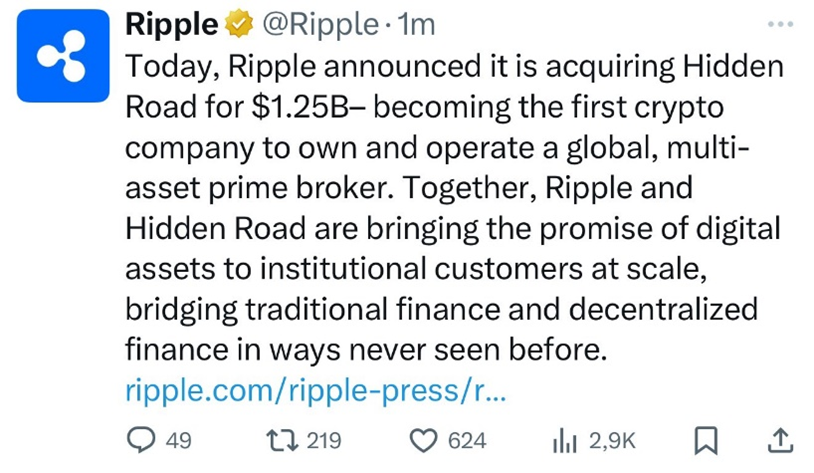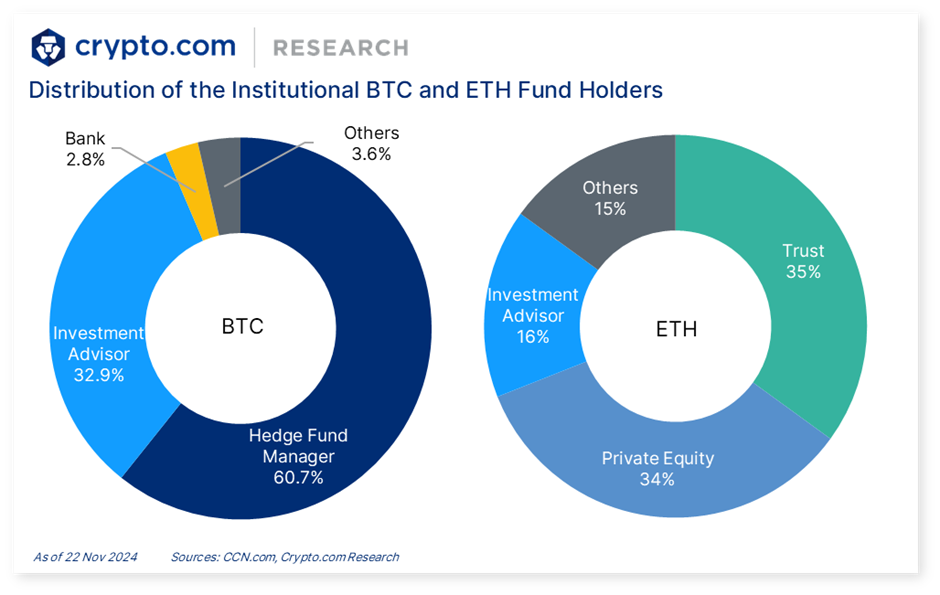The traditional and crypto financial systems are converging.
Just look at how the broad crypto market reacted in response to President Trump’s tariff announcement.
But that’s just the beginning.
In a landmark move that underscores the acceleration of this trend, Ripple (XRP, “B-”) has announced its agreement to acquire Hidden Road, a multi-asset prime brokerage firm, for $1.25 billion.
This is big news. So, let’s break it down.
Hidden Road: Ripple’s DeFi/TradFi Bridge
Ripple is officially the first cryptocurrency company to own and operate a global, multi-asset prime broker — a significant milestone in the maturation of the digital asset industry’s evolution.

Hidden Road is known for its full-service offerings — including clearing, prime brokerage and financing — across a range of asset classes, such as …
- Foreign exchange (FX),
- digital assets,
- derivatives,
- swaps and
- fixed income.
With over $3 trillion in annual clearing volume and more than 300 institutional clients, the firm is a formidable player in financial markets.
And acquisition is just the start of Ripple’s plans.
By integrating Hidden Road’s infrastructure, Ripple aims to bridge the divide between traditional financial institutions and the growing world of digital assets.
The timing is strategic. Especially as the U.S. market becomes more receptive to crypto, following the resolution of regulatory overhangs.
Ripple CEO Brad Garlinghouse put it plainly: “The U.S. market is effectively open for the first time due to the regulatory overhang of the former SEC coming to an end, and the market is maturing to address the needs of traditional finance.”
A big step in this direction revolves around RLUSD, Ripple’s USD-pegged stablecoin.
Hidden Road plans to use RLUSD as collateral across its prime brokerage products. That makes it the first stablecoin to enable efficient cross-margining between digital and traditional markets.
To anyone who questioned how stablecoins could be utilized at an institutional level, this is the answer. And it keenly elevates RLUSD’s position in the stablecoin space ... right as investors are fleeing to more secure assets.
Hidden Road also plans to migrate its post-trade operations to the XRP Ledger, Ripple's decentralized blockchain platform.
This migration aims to streamline operations, reduce costs and demonstrate XRPL's potential as a foundational institutional decentralized finance (DeFi) infrastructure.
But the impact of this decision goes beyond Hidden Road.
By showcasing XRPL's capabilities in handling large-scale institutional activities, Ripple is positioning its blockchain as a viable solution for traditional financial institutions exploring DeFi opportunities.
In fact, there are …
Broader Implications for the Crypto Industry
As digital assets gain mainstream acceptance, crypto companies increasingly seek to enhance their service offerings to cater to institutional clients.
Starting in January 2024 with the launch of the Bitcoin (BTC, “A-”) ETFs, institutions have had a hunger for crypto acquisition.

But not much has been possible for big institutions beyond having BTC on their balance sheets.
That’s why the Hidden Road acquisition stands out. It brings the blockchain to TradFi services … and clients.
Ripple's portfolio now extends beyond payments into trading, custody and lending services.
And, more importantly, a precedent has now been set. One other crypto firms that aim to integrate traditional financial services into its platforms can follow.
For instance, FalconX, a digital assets prime brokerage, has expanded its services to cater to institutional clients, including integrating foreign exchange (FX) desks and derivatives trading capabilities.
In short, there is a concerted effort among crypto firms to provide comprehensive financial services that meet the standards and expectations of traditional financial institutions.
That means a new narrative could be emerging. And while it’s not a guaranteed boost, Ripple can now claim first-mover advantage.
Industry Voices and the Road Ahead
Industry experts view Ripple's acquisition of Hidden Road as a transformative event for the crypto sector.
David Schwartz, Ripple's Chief Technology Officer, described the acquisition as a "defining moment" for the XRP Ledger, emphasizing its potential to unlock new use cases and drive institutional adoption.
Marc Asch, Founder and CEO of Hidden Road, expressed optimism about the partnership, stating …
"With new resources, licenses, and added risk capital, this deal will unlock significant growth in Hidden Road’s business, allowing us to increase capacity to our customer base, expand into new products, and service more markets and asset classes."
Of course, any extensive integration comes with risks.
Merging operations, aligning compliance processes and maintaining service quality will be critical in the months ahead.
But if successful, this could be a masterstroke, positioning Ripple as the digital Goldman Sachs of tomorrow.
Ripple’s acquisition of Hidden Road could have ripple effects — literally.
With XRP set to play a central role in this expanding ecosystem, some market watchers believe the asset could see increased demand over the next 6 to 12 months as institutional adoption grows.
That said, this is not a recommendation for buying XRP.
The market remains volatile. And future price movement will depend on various factors, including regulatory clarity, integration outcomes and macroeconomic conditions.
Even if you’re bullish on Ripple, you should still assess these factors carefully before making any decisions.
But regardless of XRP’s price action, one thing is clear: Ripple isn’t just building crypto products anymore.
It’s building a financial bridge.
And with Hidden Road now part of its arsenal, that bridge may well carry the next wave of institutional finance into the digital asset world.
No matter your opinion of Ripple, this is one development no crypto investor should ignore.
Best,
Mark Gough

